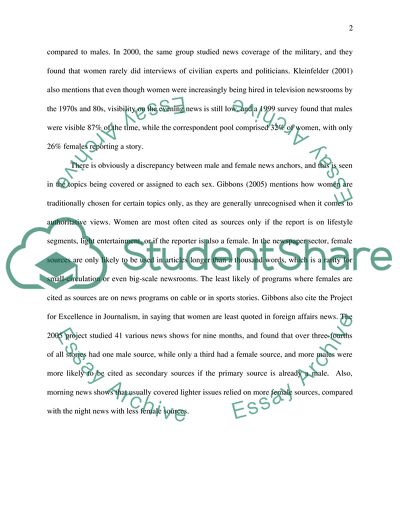Cite this document
(Sex Discrimination in Television News Article Example | Topics and Well Written Essays - 1500 words, n.d.)
Sex Discrimination in Television News Article Example | Topics and Well Written Essays - 1500 words. https://studentshare.org/gender-sexual-studies/1737671-evaluate-the-extent-to-which-we-might-understand-women-as-constructed-by-the-media-as-passive-objects-by-examining-the-representation-of-the-female-newsreadernewscaster-and-their-place-in-the-news-industry
Sex Discrimination in Television News Article Example | Topics and Well Written Essays - 1500 words. https://studentshare.org/gender-sexual-studies/1737671-evaluate-the-extent-to-which-we-might-understand-women-as-constructed-by-the-media-as-passive-objects-by-examining-the-representation-of-the-female-newsreadernewscaster-and-their-place-in-the-news-industry
(Sex Discrimination in Television News Article Example | Topics and Well Written Essays - 1500 Words)
Sex Discrimination in Television News Article Example | Topics and Well Written Essays - 1500 Words. https://studentshare.org/gender-sexual-studies/1737671-evaluate-the-extent-to-which-we-might-understand-women-as-constructed-by-the-media-as-passive-objects-by-examining-the-representation-of-the-female-newsreadernewscaster-and-their-place-in-the-news-industry.
Sex Discrimination in Television News Article Example | Topics and Well Written Essays - 1500 Words. https://studentshare.org/gender-sexual-studies/1737671-evaluate-the-extent-to-which-we-might-understand-women-as-constructed-by-the-media-as-passive-objects-by-examining-the-representation-of-the-female-newsreadernewscaster-and-their-place-in-the-news-industry.
“Sex Discrimination in Television News Article Example | Topics and Well Written Essays - 1500 Words”. https://studentshare.org/gender-sexual-studies/1737671-evaluate-the-extent-to-which-we-might-understand-women-as-constructed-by-the-media-as-passive-objects-by-examining-the-representation-of-the-female-newsreadernewscaster-and-their-place-in-the-news-industry.


